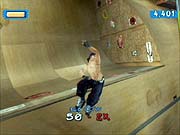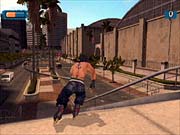More often than not, only one developer is associated with the recent alternative sports boom. But back when all this skateboarding and biking business started in earnest, there were two. Neversoft had teamed up with Activision to deliver Tony Hawk's Pro Skater, which eschewed skateboarding realism for fast, well-defined gameplay. And California-based Z-Axis had teamed up with Rockstar Games to develop a skateboarding game of their own, called Thrasher: Skate and Destroy. Thrasher had a similar goal-based, time-limited structure, but the gameplay and control were far more rooted in reality. Needless to say, the Tony Hawk series blew up and spawned an entire line of similar products for Activision. Z-Axis blossomed on its own, moving from Rockstar to Acclaim and moving from skateboarding to BMX biking by developing the deeper-than-most Dave Mirra Freestyle BMX series. Now, after a few years of moderate success, Z-Axis and Acclaim have branched out to inline skating with Aggressive Inline, an excellent game that both borrows from previous alternative sports games and sets out in a new direction that will more than likely be copied by future games.

Controlling the skater in Aggressive Inline should be familiar to anyone who has played any recent Tony Hawk game. Rather than going with the ultradeep trick system from the Dave Mirra series, Inline goes for a simpler scheme, requiring only one button to perform air tricks. But that doesn't mean there aren't many tricks in the game. There are lots of different D-pad combinations that add up to a hefty number of grabs and flips, and you'll uncover special tricks as you go. The B button is used as a general action button. It starts goals if you're near a goal trigger, and it performs Airblade-like grabs onto horizontal and vertical poles positioned throughout the game's levels. The Y button performs grind tricks, and like in Tony Hawk's Pro Skater 3, you can combo from one grind trick to the next without leaving the rail. Tony Hawk 3's revert, which lets you continue combos after landing a vert trick, is seen here as the cess slide, though the timing on the cess slide to manual is a bit trickier when you're first getting started.
Aggressive Inline's levels are really quite huge. As a result, the old two-minute timer that just about every single previous game in the genre has used is history. You can skate around the levels at your own pace. The only time you'll have a time limit is when you start a time-based goal. The other thing you have to watch is your juice meter, which acts as both a countdown timer and your special meter. As you land tricks, the meter fills up. Wrecking or just standing around causes it to slowly drain. If it drains completely, the game ends, but keeping it filled is never difficult, so the meter seems more like a formality than something you actually need to be careful of.
The rigid goal structure of previous games is gone here as well. Each level has a long list of goals, including the standard points- and time-based goals, but more of the game's goals are focused on doing tricks on specific parts of the level, like grinding on three traffic lights or transferring between two distant quarter-pipes. Like some of the goals in Dave Mirra 2, most of the goals in Aggressive Inline are discovered by talking to people in the level. Others force you to use the game's level editor to build a quick course in an empty room and then skate it for points. Completing goals unlocks more levels. At first, completing goals is a breeze. Points are easy to come by, as the game doesn't penalize you much for using the same tricks over and over again, and keeping your balance on rails is easy enough to let you rack up huge grind combos on any circular edge. But there are always one or two goals per level that seem to be far more difficult than the rest. These goals usually just require you to spend some time eyeballing the surrounding area to discover a line that will reach your objective. Also, each skater starts out fairly weak in almost every category. You improve your stats by performing moves that require the stat you want to increase. So skating superfast improves your speed rating. Doing trick combos while riding backward raises your fakie stat. Grinding, wall riding, and a few other categories can be raised in the same manner.

The models and animation in Aggressive Inline look great. Likewise, the game's environments are large, and they use bright, colorful textures. The level geometry isn't the smoothest in the world, but the level size more than makes up for this trade-off. The game also sounds good, with great representations of the sounds of skating, grinding, and hitting the pavement. Aggressive Inline also features a licensed soundtrack that includes tracks from Sublime, Rakim, P.O.D., and more.
Aggressive Inline is a success on several levels. The large number of goals in the game vary in difficulty, giving newer players something to do while not skimping on the difficulty. It also manages to take the gameplay and design concepts that have worked well in past games and give them enough of a face-lift to make the game feel new. Finally, its innovations with regard to timed-run and in-level goal designs are sure to become trends used in the next generation of alternative sports games. For all those reasons, fans of Tony Hawk or Dave Mirra will surely find a lot to like in Aggressive Inline.